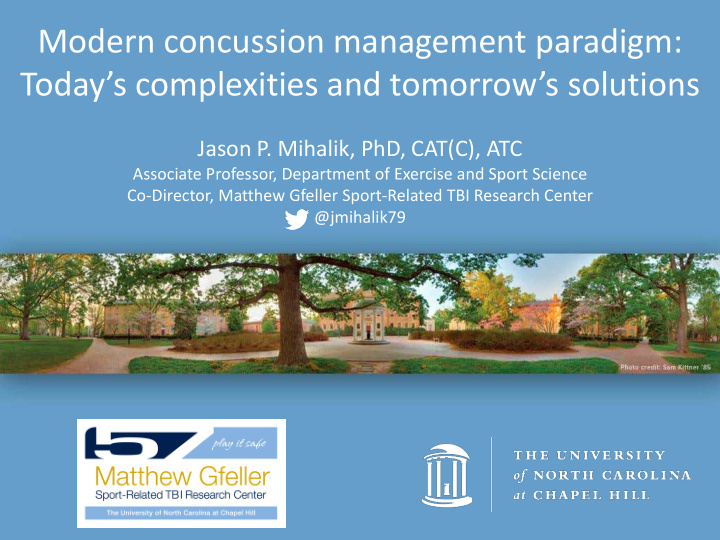



Modern concussion management paradigm: Today’s complexities and tomorrow’s solutions Jason P. Mihalik, PhD, CAT(C), ATC Associate Professor, Department of Exercise and Sport Science Co-Director, Matthew Gfeller Sport-Related TBI Research Center @jmihalik79
Disclosures Chief Science Officer
“It’s not dangerous to play with a concussion. You’ve got to sacrifice for the sake of the team. The only way I come out is on a stretcher.”
Cumulative risks for youth athletes S hould kids be playing contact or collision sports?
60% 50% 40% 30% "Concussion" "Bell Ringer" 20% 10% 0% Valovich McLeod, 2008 Register-Mihalik, In Progress
Concussion evidence Number of “sport concussion” publications in PubMed 3000 2500 2000 1500 1000 500 0 PubMed search string “sport concussion” on 12/07/17
Concussion: A multifaceted condition Mechanism of Physical exam injury Postural stability Symptomatology Knowledge, Concussion Attitudes, history Behaviors Traumatic Brain Cognition Treatment Injury
Concussion evaluation
Standardized concussion protocol Preseason Injury Clinical Follow-up Baseline • Symptom • Evaluation • Asymptomatic • Mental status • Symptom • Cleared for progression • Balance • Mental status • Cleared for full • Neurocognition • Balance RTP
Bucket Match Symptom Com. 1. Headache Symptoms Com. 2. "Pressure in Head" Com. 3. Neck Pain by Bucket Com. 4. Nausea or Vomiting Bal./Mot. 5. Dizziness V-V 6. Blurred Vision Bal./Mot. 7. Balance Problems V-V 8. Sensitivity to Light Com =Comfort Bucket V-V 9. Sensitivity to Noise Monitor 10. Feeling Slowed Down Cog =Cognitive Bucket Monitor 11. Feeling like "in a fog" Com. 12. "Don't feel right" V-V =Visual Vestibular Bucket Cog. 13. Difficulty Concentrating Cog. Bal./Mot =Balance/Motor 14. Difficulty Remembering Bucket Monitor 15. Fatigue or Low Energy Cog. 16. Confusion Monitor =Activity that does Monitor 17. Drowsiness not fit in activity bucket but Monitor 18. Trouble Falling Asleep should be monitored for Monitor 19. More Emotional change (as should all Monitor 20. Irritability symptoms) Monitor 21. Sadness Monitor 22. Nervous or Anxious
Concussion evaluation
Longitudinal perspective on concussion ACUTE REPETITIVE LONG-RANGE ~30-50 yrs INJURY CONCUSSION OUTCOME True Incidence, Risks, Latent Pathophysiology? Need for prospective, longitudinal, population-based studies Courtesy of Dr. Michael McCrea
Courtesy of Dr. Michael McCrea
Multidimensional Intervention Progression Framework Phase 4 – Phase 1- Phase 5 – Recovery Phase 3 – Phase 2 - Impairment Symptom Control* Sport Specific Acceleration Reduction Applications • 1 st Session – Activity Integration •Relaxation/contorol •Relaxation/control of relaxation/control of •Continue to add new Relaxation/control of of symptoms, can symptoms- 1-2 symptoms (manual areas and increase symptoms as continue to add 1 activities from the therapy, massage, complexity as needed, can new area per session same bucket around etc) needed continue to add 1 and increase with continuing to new area to address •Each session after – •Activities should complexity of increase complexity of impairment with Comfort + 1 bucket include divided existing areas – in that bucket/area each session activity around attention tasks and including divided impairment be sports-specific attentions tasks
Cognitive Balance Visual Dual-Task Active Rehab + Graded Exertion Progression Techniques Techniques Techniques Techniques Simple Math Foam EC: DL, SL, Gaze Stability Rocker Board + Active Rehab Group Only 1+2; 3+1 Tandem Stroop • We expect that each session will last 15-20 minutesminutes, regardless of phase Stroop Say yes if color the same as the word – BLUE Ball Toss N-Back State if the letter you Bosu/Dynadisc see is the same as the Bosu Ball lunges + COWAT one you immediately saw before- A B A A Pencil-Push Serial 7s Count backwards from 100 by 7: 7 14 21, etc
Safer football, taught from inside the helmet Identify at- Intervention Reduce risk risk players
Neuroimaging: Structural and clinical sequences Plasma/serum biomarkers Vision & sensory performance Standard TBI clinical measures
Imaging the Brain for Chronic Effects • Diffusion Tensor Imaging (DTI)
Matthew Gfeller Center
Jason P. Mihalik, PhD, CAT(C), ATC Matthew Gfeller Sport-Related TBI Research Center jmihalik@email.unc.edu 919.962.2573 http://tbicenter.unc.edu @jmihalik79
Recommend
More recommend